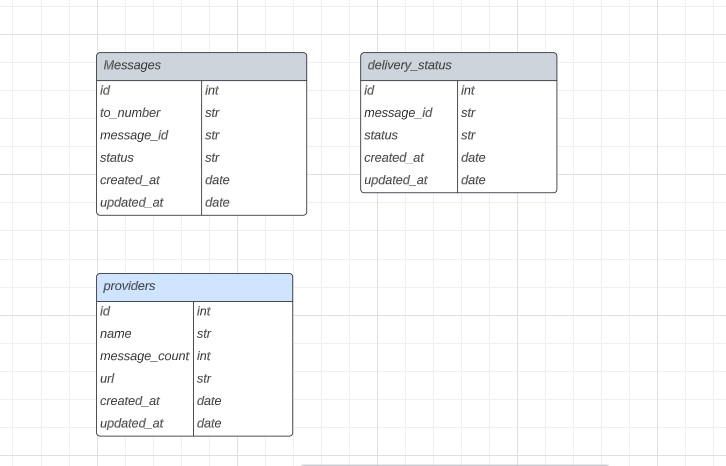This is a Rails API designed to send text messages. The API serves as a messaging service that receives messages from clients and subsequently dispatches these messages to multiple SMS providers. Its primary function is to facilitate the seamless delivery of text messages to the intended recipients using various SMS providers as delivery channels.
- Requirements
- Recommended modules
- Installation
- Configuration
- Troubleshooting
This module requires the following:
- Ruby version 3.1.2
- Ngrok
- SQLite 3
-
Clone the Repository: Open your terminal and navigate to the directory where you want to store the Rails application. Then, use the git clone command to clone the existing repository:
git clone https://github.com/imhilla/texting_service.git -
Navigate to the App Directory: Change into the newly cloned app directory:
cd texting_service -
Install Dependencies: In your app directory, run the following command to install the required Ruby gems specified in the Gemfile:
bundle install -
Set Up the Database: Run the following command to create the database and set up the initial database schema:
rails db:create db:migrate -
Start the Rails Server: Now, start the Rails server using the following command
rails serverYour Rails application should now be up and running. Access it by visiting https://localhost:3000 in your web browser. -
Set up Ngrok. To expose the delivery_status route using ngrok, follow these steps:
-
First, download and install ngrok from the official website (https://ngrok.com/download). Ngrok allows you to expose your local server to the internet with a public URL, which is useful for testing webhooks and other external API integrations.
-
Start the Rails Server Ensure that your Rails server is running. If it's not already running, start it using the following command in your Rails app directory.
-
Expose the Rails Server with ngrok Open a new terminal window, navigate to the directory where ngrok is installed, and run the following command to expose your local Rails server.
ngrok http 3000 -
Here, 3000 is the default port on which the Rails server runs. If your Rails server is running on a different port (e.g., 4000), replace 3000 with the appropriate port number.
-
Obtain the Public URL After running the ngrok command, you will see an ngrok-generated public URL in the terminal. It will look something like https://abcd1234.ngrok.io.
-
Update call_back_url - Head over to
app/controllers/concernsand update the call_back_url examplecall_back_url = "https://5ab8-41-80-118-187.ngrok.io/delivery_statuswith your new ngrok web hook.
-
Before you start using the api you will need to run a few end points to set up providers. To load balance
the app has been configured to allow url porviders to be created throught end points, without it the sms service will not work correctly. head over here, and send a POST request to https://127.0.0.1:3000/providers make sure you switch the url of the provider to set up the secon provider. Alternatively you can download postman collections from collections directory /collections/text_service.postman_collection.json and proceed from there.
- Example for provider one `{ "name": "provider2", "message_count": 0, "url": "https://mock-text-provider.parentsquare.com/provider1"}`
- Example for provider two `{ "name": "provider2", "message_count": 0, "url": "https://mock-text-provider.parentsquare.com/provider2"}`
Incase you experience any issues please reach out to me for clarification.
Before running bundle exec rspec make sure to run bundle install to install gems.
Then run bundle exec rspec from root directory.
- To track how load balancing is working please send a request to
get_all_providersfrom postman to see howmessage countis at the rate 30% to 70%
The database schema consists of three straightforward tables. The first table is responsible for storing the messages to be sent, the second table tracks the message count, and the third table is responsible for tracking the delivery status and updating the status of each message.
When a request is sent to the send_message endpoint, it is directed to the message controller, which then communicates with the client. In the background, the create method checks if the message is empty. If the message is not empty, we proceed to verify if the provided number is valid and whether the message was previously sent. If the message has not been sent before, we proceed with sending it.
Upon successful delivery of the message, if we receive a message ID in response, we increment the message count. This serves as a mechanism to track the number of times requests were sent, thereby enabling load balancing to efficiently manage the distribution of messages.
The send_sms method is executed in the background using a job. When a request is received at the https://682b-41-80-118-187.ngrok.io/delivery_status endpoint, it updates the status column in the message table. This allows us to track the status of a message using the received message ID.
In summary, the message is sent, and the callback function is utilized to update the message status.
We already have a way to track requests sent to each provider via the message_count column, you can see the counts
from sending request here https://127.0.0.1:3000/providers - example
`[{
"id": 1,
"name": "provider1",
"created_at": "2023-07-20T06:06:24.096Z",
"updated_at": "2023-07-20T08:16:36.689Z",
"message_count": 3,
"url": "https://mock-text-provider.parentsquare.com/provider1"
},
{
"id": 2,
"name": "provider2",
"created_at": "2023-07-20T06:06:48.594Z",
"updated_at": "2023-07-20T08:17:00.989Z",
"message_count": 7,
"url": "https://mock-text-provider.parentsquare.com/provider2"
}]`
-
By establishing a relationship between a message and provider, we can enhance tracking capabilities by storing the provider_id as a column in the message table. This approach allows us to easily determine which provider was used for a specific message, providing more comprehensive information beyond relying solely on the message ID.
-
We can further enhance the codebase by modularizing the HTTP part of sending external requests into its own HTTP module concern. This approach promotes better code organization and reusability, making it easier to manage the HTTP-related functionalities across different parts of the application.
-
We can establish relationships between the Provider model and Message model by defining associations. In this setup, a Delivery belongs to both the Provider and Message models, creating connections that facilitate data retrieval and navigation between these entities.
